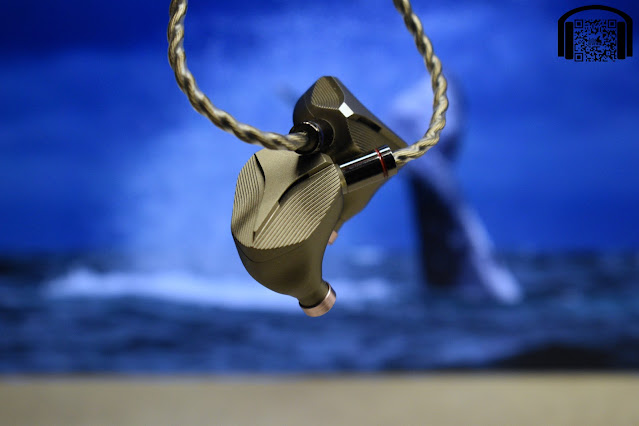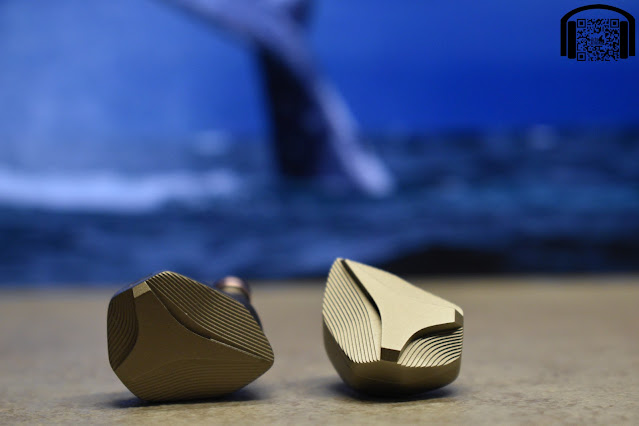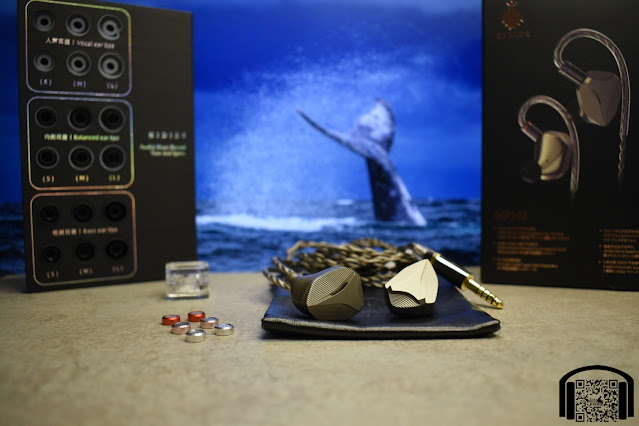- Get link
- X
- Other Apps
English | Español
TLDR version on YouTube: TDLR - Hidizs MP145
The Hidizs MP145 have been sent to me directly by Hidizs in exchange for me posting my thoughts and opinions in this review. The only request was that I publish the review as close to the official launch date on Kickstarter, 6th of September, as possible. I will, as always, do my very best to be as unbiased as humanly possible in my review, yet it is always good to consider the fact that these IEMs have been sent to me free of charge.
You can find the official Kickstarter page for the MP145 here: https://www.kickstarter.com/projects/hidizs/hidizs-next-gen-ultra-large-planar-hifi-iems-9-sound-types?ref=7ke7sd
As always, this is a non-affiliate link, meaning I do not receive anything in exchange for clicks or purchases made. However, in the case of this link that Hidizs asked me to publish, it does include tracking. In other words, if you click on the link, Hidizs will see that the person has come from my review. I guess they want to see if I am worthy of being sent review items or not 😉
To avoid being repetetive in my reviews, you can find all the info about how I create the reviews, equipment used, how I receive the products and how to interpret my reviews by visiting: About my reviews
Intro…
It seems like quite some time since the planar boom died down, with the latest trend being combining them with other drivers in hybrid configurations. However, Hidizs presents us with their latest model that is using an “Ultra-Large” planar driver according to them. This is to say that the MP145 are using 14.5mm planar drivers, along with three individual tuning nozzles to tailor the sound to your preference. These are currently available on Kickstarter for an early bird price of $109, which may not make them the cheapest set of planars on the market but still puts them in a reasonable budget category.
For those of you that don't know how Kickstarter works, basically you make a pre-purchase of an item and it is shipped to you at a later date. The earlier you join the list, the cheaper it is (in the case of the MP145). Usually this is used for companies to raise funding to create a product that is only in the design/prototype phase. In this case, as you can see from my review (and probably many more reviews that are being published), the IEMs already exist, so it is a little bit of a strange way to use Kickstarter.
I will get to the sound in a moment but something that is certainly worth mentioning about this model is the fact that Hidizs is collaborating with the WDC, which is for Whale and Dolphin Conservation.
Here is some info that Hidizs provided me:
“Hidizs x WDC cooperation info.
WDC (Whale and Dolphin Conservation) is the leading global charity dedicated to the conservation and protection of whales and dolphins. Inspired by the Whale Tail & Rorqual Pleats Design of MP145, we're collaborating with WDC to raise awareness of whales' vital role in nature and ocean health. As part of our commitment, we have formed a preliminary agreement for collaboration and assistance. We will maintain open communication with WDC and provide the necessary support to aid their work. Specific details about the donation can be found on Hidizs and WDC's official social media platforms and website. Further information will be provided after the campaign.”
I applaud any kind of initiative that helps charities and in this case, as someone who has spent a lot of time at sea, I am happy to see them collaborating with the conservation of Whales and Dolphins. No matter if the outcome is small or large, every little bit counts in the attempt to save our oceans and I hope it turns out to be a very useful collaboration.
This will not affect my opinion on the sound of these IEMs but does of course mean that I am starting on a positive note with them.
Presentation…
The usual cardboard sleeve, with images and specifications of the IEMs, slides away to reveal a not so usual plastic box with a lift off lid. While it is something different, I find it strange that Hidizs would decide to collaborate in saving the oceans and then opt for using more plastic than necessary in the product packaging. Saying that, it is quite a sturdy box which I am sure will come in useful for storage, so at least it isn’t going to get thrown away.
Inside the box we find the IEMs sitting in foam cutouts at the top of the box, with a smaller cardboard below it that contains the cable, a spring top pouch and a user manual together with the usual paperwork.
There is no mention of the collaboration with the WDC on any of the paperwork or the box, which I feel is a bit of a missed opportunity but maybe something will be included with the actual retail version (remember that this is a pre-production unit, so things may be slightly different). The user manual also says that they are “Mermaid Series Earphones”, which I guess is sea related.
Underneath the foam cutouts and the accessories box, we find a tray in the bottom of the box that contains 9 sets of ear tips, with three different types. These are labelled as “Vocal”, “Balanced” and “Bass”. Personally I found the medium size “Balanced” to be my preference and are the tips that I have used throughout this review.
Build and aesthetics…
The IEMs are certainly on the large side of things, also being a bit heavier than many other sets, although still reasonable. The shape of the shells has been inspired by the tail of a whale and this does show when looking at them. This also means that they have some strange shapes going on on the outer part of the shells which looks uncomfortable but actually, in my case, does not affect the comfort at all. I in fact find them comfortable for long sessions, even if they are on the large side.
They are available in 3 colours: silver, black and titanium. Hidizs asked me which colour I would like and I chose the titanium, just to break from the norm of silver or black, and I have to say that I am a fan of them. They look good, seem to be well built and, as I already said, they are comfortable.
The matching cable also looks very good and gets high praise from me. It’s a quadruple weave that breaks into two wrapped cores on each side, along with matching metal hardware (and 4.4mm in my case). It is not microphonic, not too thick and is, in general, a very pleasant cable.
Sound…
All tracks mentioned are clickable links that allow you to open the reference track in the streaming service of your choice (YouTube, Tidal, Qobuz, Spotify, etc.)
As mentioned in the intro, the MP145 come with three sets of filters that screw on to the nozzle and allow you to change the tuning to suit your tastes. There are not huge differences between the three filters but they are enough to be clearly noticeable when swapping.
Here is a graph of the 3 nozzles with my usual preference target for reference:
Let’s get the red nozzles out of the way first as I am not a fan of them. With these filters I find that the upper mids / lower treble is reduced too much, making vocals lack presence and putting too much emphasis on the low end. There is actually some higher treble presence that stops them from sounding completely dark with these filters and I can see some people enjoying this signature, just I am not one of them.
So, focusing on the Silver and Gold filters, the differences between them are quite minimal in comparison to the Red ones, especially if looking at the graph. When listening, I find that the upper ranges of the Gold filters seem slightly less peaky than the Silver ones and, although it does bring the bass slightly more forward, I found myself preferring the Gold option.
To be honest, both filters have a bit too much in the mid bass region for my personal preferences but I find that the sound signature with the Gold filters is slightly more coherent overall than with the Silver (and more preferable to me personally than the Red filters). I think that the Gold filters generally present a smooth and bassy signature which can be considered a fun listen.
So, I am going to focus on the Gold filters and share my usual detailed opinions on the result of listening to my test track playlist.
While I would usually separate the subbass and midbass regions, I feel that on the MP145, these areas work together to present a full bodied and rather “thick” bass range in general. Although I use the word “thick” (for lack of a better term to describe them in my opinion), that doesn’t mean that they are loose and boomy. In fact, although there is a clear focus on the bass range, the IEMs do a decent job of being coherent when tasked with bassy tracks. The MP145 are very reminiscent of the Letshuoer S12 in these bass ranges, which, as a fan of the S12, is a good thing. I do feel that the MP145 put more emphasis on the lower ranges than the S12 but that is due to the upper regions, which we will get to shortly.
To refer to my usual subbass test, “Chameleon”, there is plenty of rumble going on with the additional boost of the midbass, which makes for an impressive low range on the track, with the MP145 doing a decent job of keeping it under control. I can’t say it is the best I have heard in these lower ranges but it is still impressive nonetheless.
Moving to something less rumbling but still in the electronic domain, “Shot Me Down” has a much cleaner and more defined low end, with bass hits being clean and distinct. With “No Sanctuary Here”, which is sort of halfway between the two, again the bass range performs well, with clean and defined notes that give the sensation of very good bass.
Moving into the mid range, it is nice to see that the bass doesn’t invade it and make things muddy in the lower mids, unless of course you have something extremely boosted going on in the mid bass range.
Instruments and lower ranges of vocals are clean and present, with a decent body to them but without becoming overly muddy. “Elephants on Ice Skates” presents a large bass guitar in the lower ranges, with a cleanliness to the mid range of both the guitars and the bass that is not invaded by those lower notes.
Listening to “These Bones”, those low vocals have a nice body to them but without becoming overly warm and interfering with the other vocals of this acapella track.
The upper mids leading into the lower treble is where I am least fond of the MP145 tuning. While the rise to 2kHz is enough to bring vocals forwards and not get lost against that lower range boost, the response dips just after this mark and returns with a small peak at around 5kHz.
I have said plenty of times in the past that I am very sensitive to 5kHz peaks and while the MP145 is not overly boosted at this mark, the dips surrounding it make that frequency stand out much more, making things quite harsh to my ears. For example, Zella Day in “Seven Nation Army” has a harshness to the vocals that I can find quite uncomfortable.
This can be tamed quite a bit by using the Red filters, yet I find that swapping to the Red’s reduces the 2 to 3kHz region too much, putting more emphasis on the lower ranges and making vocals lack presence.
Moving into the upper ranges, there is quite a nice extension and sensation of air that stops the overall signature becoming dark and overly bass focused. Even with the Red filters, the upper ranges are nicely recovered, making the presentation bass focused but not overly dark in general. Yes, you lose that vocal presence that I just mentioned, but it doesn’t become dull and dark.
Details are pretty good, easily appreciated without being made the center of attention. When a track has a lot of detail going on in the background, the MP145 make it apparent but without making it the focus.
I also find soundstage to be above average on the MP145, with images nicely located and spread out in a left to right stage. As an example, “La Luna”, which is a binaural recording, has a nice placement of the instruments, each with their own location, although I find the back left guitar to be more “left” and slightly less “back” than on some other sets.
Conclusion…
I think that the planar novelty has worn off and is now more about the performance of the IEMs than the fact that they use planar drivers. In the case of the MP145, I think Hidizs has presented a very respectable set of IEMs at a very reasonable price. They are not the cheapest planar out there (nor are they the most expensive, by a long way), but in terms of performance for cost, I would say they do a good job.
Also, add to it the fact that they are collaborating with the Whale and Dolphin Conservation and, while this may not change the way it sounds, it does give them more points in my personal opinion.
In general, I think that if you are looking for a good all round set of planars and you like a bit of additional bass presence, then the MP145 are a good option. You also get the 3 different filters to adjust them to your preference and maybe go for that extra bass emphasis when you are in the mood!
All FR measurements of IEMs can be viewed and compared on achoreviews.squig.link
All isolation measurements of IEMs can be found on achoreviews.squig.link/isolation
To comment or contact, visit any of the following social media platforms:







